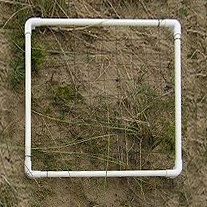
Quadrat device in ecology

Quadrat device in ecology
A quadrat,
first used in the early 20th century, is a rigid frame,
typically 0.5 or 1.0 meters square, used to
measure the contents of a random sample of plant diversity
within the surrounding area. Traditionally, a small stone thrown
over the shoulder sets the south-west corner for placement of
the quadrat in a SWNE orientation. The numbers of
plants of each species within the quadrat are then counted. Note
that this quadrat is further divided into a 10 x 10 cm grid
by wires, if a finer mesh is desired. Multiple quadrats may be
used to re-sample a given area. Quadrat data may also be
recorded as 'presence / absence' or '+ / -'
counts, where the occurence or non-occurrence of a plant of
interest is noted rather than the actual count.
The composition of a quadrat can also be determined from a photograph of the quadrat, or with a camera with fixed height and field size, and species counts determined afterwards by eye or a computer. Vertical composition of a quadrat may also be determined by a laser scanner.